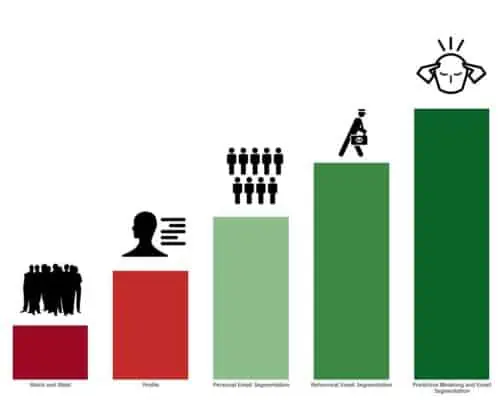
Email marketing segmentation is the practice of businesses taking their full database of email subscribers and dividing the contacts into smaller segments for a more targeted or personalized experience. Businesses divide subscribers by grouping recipients based on sets of similar criteria, such as demographic information, subscription source, and purchase history. With these segments in place, marketing departments can use the lists to deliver more relevant content to individuals in those groups as opposed to sending a singular message to all.
What is Email Marketing Segmentation?
List segmentation, also known as email marketing segmentation, enables businesses to tailor their advertising campaigns and messaging to the preferences of specific target audiences. You group your email contacts into several targeted groups based on shared traits.
You may establish these groups in several ways, including demographics, industry, profession, business needs, and more, as we’ll see below. After categorizing your email contacts, you can send coordinated messages to groups of people that share common traits.
Why Use Email Marketing Segmentation?
Segmentation ensures that you are only sending messages to the right people. You aren’t spamming people with messages of no interest to them. Email marketing segmentation enables you to:
- Send personalized content
- Nurture leads down the marketing funnel
- Identify untapped market opportunities and segments
- Improve email marketing return on investments (ROI)
- Increase your open rates and conversion rates
- Decrease the cost per click on your emails
Mailchimp found that segmented campaigns received 14.31% more opens than non-segmented campaigns, 10.64% higher unique opens, 100.95% higher clicks, 4.65% lower bounces, 3.90% lower abuse reports, and 9.37% lower unsubscribes.
Importance of email marketing segmentation
More than 246 billion emails are sent and received each day — of those, 128 billion are for commercial purposes, according to research from Radicati Group Inc. Email segmentation can determine whether a consumer opens or deletes an email because there are so many emails that end up in their inboxes.
Businesses can benefit from list segmentation in a variety of other ways outside just being able to offer customized and pertinent material to specific groups of subscribers, such as:
- higher open rate and more clicks;
- increase in email revenue; and
- increase in repeat customer business.
Email marketing segmentation strategies

To take advantage of email segmentation benefits, there are several strategies that businesses can use to collect customer data and divide their contact lists.
Select an email marketing platform
Many small businesses begin by creating contact lists using their standard email software, like Microsoft Outlook or Gmail. Still, an email marketing platform is required to manage several lists and communicate to bigger audiences.
Platforms for email marketing can serve as a database for all business relationships. Companies may send tailored emails while focusing on improved deliverability rates and reporting on email marketing engagement, thanks to the ability to collect data and use it for list segmentation.
HubSpot, ActiveCampaign, MailChimp, and Constant Contact are a few email marketing solutions.
Use forms to collect contact data.
Using website forms is the easiest way to collect demographic information about contacts. Some critical information for list segmentation includes:
- company name
- organization type
- job title
- income
- age
- birthday
- number of people (including children) in household
- marital status
- geographic location
- education level
- gender
Teams can decide which fields to include on particular forms to collect data pertinent to their business.
Businesses can personalize their messaging to a greater extent with more prospect information.
Send a welcome email.
Businesses frequently don’t know what list to put a prospect on when they enter a database with little or no information.
Marketing teams can direct a user toward content they might be interested in by sending them a welcome email containing various links and content recommendations. Users can determine which list they could fit into best by doing this.
This email may also direct recipients to a form that must be filled out for businesses to collect data from the initial database entry and for customers to provide enterprises with more insight into the type of emails they should send.
Track customer entry point

For businesses to deliver relevant content and email marketing to customers, tracking when website visitors arrive and what content they interact with is critical.
By including a visitor converter on a website landing page, such as a contest or advertisement promoting a particular product line or service, businesses may persuade visitors to become customers and learn what information and content users are interested in.
Businesses can use web analytics software like Google Analytics to monitor the traffic, clicks, and bounce rates on the websites that customers and prospects visit. With that knowledge, marketers may include relevant material in subsequent email marketing campaigns tailored to customers’ suggested needs and interests.
For instance, if a prospect interacts with a piece of top-of-funnel information, organizations can group users into a list of contacts who have downloaded that content. The subsequent emails can send content that helps move them further down the sales funnel.
Segment prospects and customers
Prospecting is crucial for boosting sales, but returning consumers should receive equal attention from firms. It is essential to build different email lists for prospects and clients. Creating tailored emails for this demographic is an excellent approach to boost retention and customer lifetime value because it is simpler to sell to existing customers.
Customers happy with their purchases from a business are likely to do business with them again. Still, companies may also utilize this strategy to upsell or cross-sell goods and services to loyal customers.
Segment by Engagement
Frequently, a corporation will have several marketing efforts active simultaneously. Marketing teams can decide where to place a person in a campaign or process using email segmentation based on engagement.
Businesses can send out a succession of emails to a user until they interact with the information, for instance, if the objective of a marketing campaign is to encourage a prospect to download a white paper.
Businesses can add users to additional lists or marketing campaign streams once they interact with the material to provide the next item or offer. Giving each user the appropriate material at the proper moment moves a user up the sales funnel and keeps engagement high.
Send emails based on the shopping cart or form abandonment.
Both B2B and B2C businesses can be satisfied with this combination approach. According to a Baymard Institute study, 68% of shopping trolleys are abandoned before being filled with goods.
Emails can rekindle the initial excitement in buying that product by using a cart abandonment program, frequently with a discount offer.
Form abandoners are a fact of life for B2B organizations. Perhaps the visitor wasn’t interested in the offer, but recapturing them with other offers is a similar tactic used by e-commerce businesses to convert leads.
Send out referral emails
Customers that recommend the brand to other companies and potential customers are some of the best customers in a company’s database. Businesses can launch email campaigns to these connections asking for referrals or even their case study posted online by segmenting these contacts into their list.
Maintaining open lines of communication with this demographic will increase brand equity and referral-based revenue.
Segment lists by geographic location
Companies that provide goods and services nationally or internationally would profit from segmenting lists based on the consumers’ locations in their database. The business might tailor its services with promotional efforts based on seasonal or local expertise.
For instance, an organization that sells landscaping equipment might advertise new snowblowers in snowy areas rather than warmer locations. Time-based email messages are also helpful in getting into inboxes when it makes the most sense by staggering sends at the best moment in various time zones.
Email Marketing Segmentation For Small Businesses
Small businesses can engage with clients and create relationships with email marketing. Finding the ideal approach to use email marketing for your company, though, can be challenging.
Email marketing can be one of your most effective methods, whether you’re in charge of a minor or huge company. It can boost your conversion rate and expand your consumer base if done correctly.
Marketers who deploy segmented campaigns report a rise in revenue of up to 760%. Email marketing segmentation is crucial for creating customer relationships, fostering loyalty and trust, and boosting revenue for small businesses.
Email Marketing Segmentation For Beginners
One of the most efficient ways to expand your business is through email marketing. But it can be challenging to decide with so many options accessible.
Furthermore, overly sophisticated segmentation approaches when you are just getting started may look overkill.
You need not be concerned. All the methods outlined in that article are applicable. A/B testing can be the one thing you need to perform more of because you are new to the industry. An excellent technique to ascertain whether an email campaign will be successful is through A/B testing.
This works best when your emails are designed and intuitively. You should always utilize plain text and big fonts to make reading your emails easier. Avoid overwhelming your audience with excessive details or images; get back to the basics and see what sticks!
Past Purchases For Email Marketing Segmentation
Segmenting customers based on previous purchases is another simple technique to improve targeting.
By looking at their purchasing habits, you can upsell or cross-sell complementary products or services to clients on your email list. Future client buying trends can be predicted using past purchasing patterns.
This enables more successful marketing strategies to persuade buyers to purchase particular goods. You can send out targeted emails to consumers who might be interested in a new product by using the information gathered from past purchases and your customer’s email address.
Website activity For Email Marketing Segmentation
Another easy way to learn more about visitors’ interests is to monitor website activities.
To learn more about your audience, including where they are coming from, how long they remain on your site, which pages they view, and other information, utilize Google Analytics or any other free service.
A bargain might pique the interest of visitors to your product pages. Send them an email highlighting some of your best-selling items and current promotions.
Conclusion
You may learn email marketing segmentation from this guide. It is simple to understand why the technique has been so well-liked recently. You can communicate with your consumer base and ultimately improve conversion rates by segmenting your consumer base.
Not all brands with the most sophisticated marketing automation tools use email marketing segmentation as a strategy. You can start targeting your audience immediately with these simple segmentation tactics if you have a primary email marketing service and a little imagination.
All the best to you!

Pingback: 5 Ways to Improve Omnichannel Customer Experience – Sourcing Agent Dropshipping News